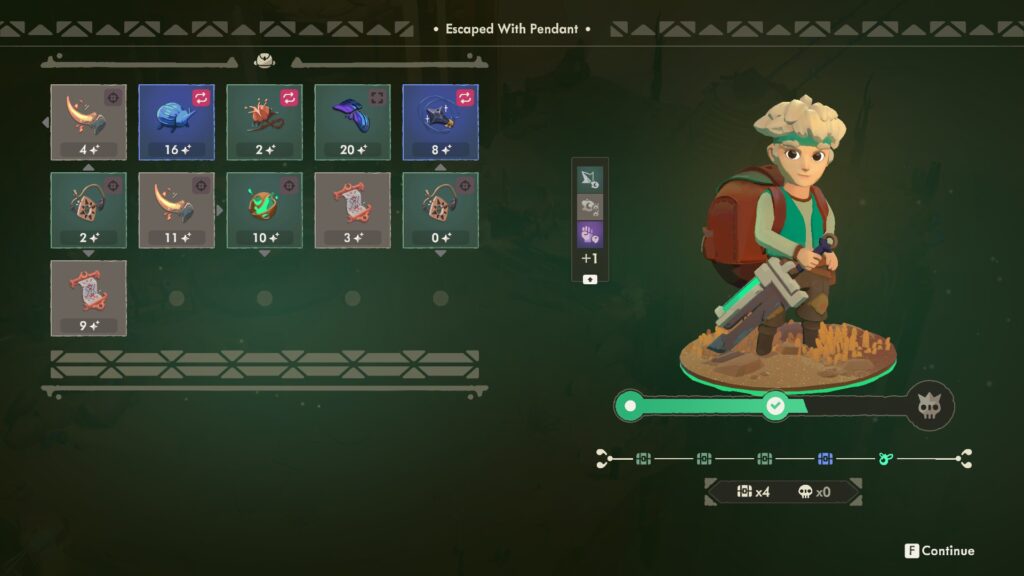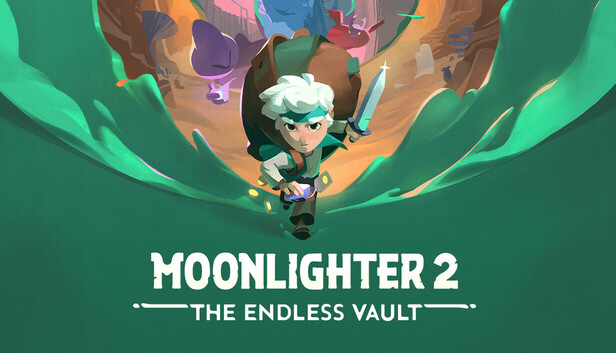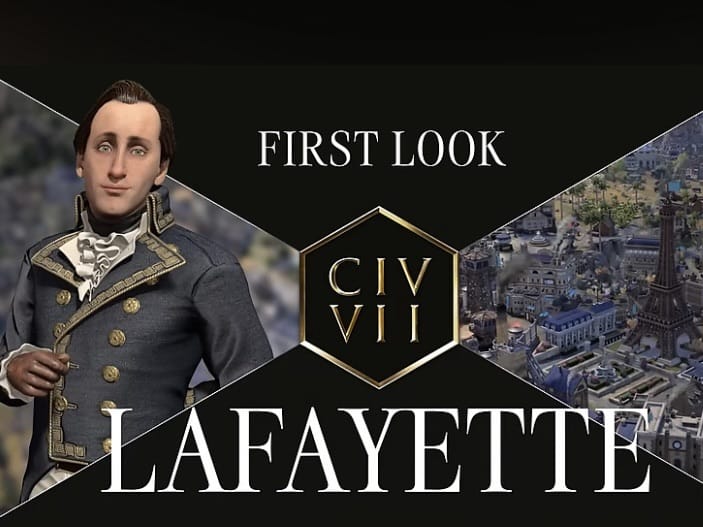Moonlighter 2: The Endless Vault arrives in early access this month, a sequel that changes up what made the first game charming rather than simply polishing it. Digital Sun keep the original’s core identity, the push and pull between dungeon risk and shop reward, but have moved from a 2D pixel art dungeon crawler to a 3D pick your path roguelite. The result is familiar in spirit yet often refreshingly different in execution.
What’s new?
The sequel moves from pixel art to a full 3D world, which changes combat pacing and spatial clarity in ways that mostly work but sometimes remove the charm that many fans (including myself) loved. Runs now offer branching choices, a perk system, and meta decision points that lean into pick-your-path design, making dungeon runs feel more intentional and build-driven. Inventory management has been expanded from only being able to put certain items in certain locations into a small puzzle system where relic placement triggers synergies, burns items, or transfers value, which means you’ll be spending a lot more time mid run trying to ramp up the rarity of your stuff. The shop has also been reworked so selling becomes a self-contained session of boosts, temporary perks, and pricing that turns each selling session into its own run with choices and rewards.

Dungeon Crawling
The shift to 3D brings faster, more combo-oriented combat. Will now has weapon combos, a gun, and a backpack-attack that can be used to interact with enemy states and the environment, which rewards spatial thinking such as sending foes into traps or off ledges. Enemies have a few different attacks to choose from, so you’ll need to pay attention to their tells to avoid getting combo’d by a bunch of slimes or zapped to death by little robots. I really enjoyed the new additions to the combat system; particularly firing big guys into traps with my backpack and then running up to wail on them with my berserk mode activated. There’s also mid run combat perks like shock and foam, that do secondary damage so you can give yourself a little more space if you’re low on health.

Where Moonlighter’s combat often trended toward a measured rhythm that complemented town-life pacing, the sequel leans into short, punchy runs with distinct build choices every time you enter a vault. The new perk selection and visible path choices mean you are deliberately pathing a run to optimise loot or combat abilities, reminiscent of other recent roguelites, which is exciting but also reduces some of the original’s improvisational charm.

I am not sure about the new pick a path system. I liked the more dungeon crawler nature of the original game and the slower, exploratory feel of its runs. The current system gives more structure and deliberate choices, which is interesting, but it sometimes feels like it replaces the open exploration that made dungeon runs feel like small adventures. If I was low on healing I’d generally opt to end my run there and keep my loot, whereas in the first game I was much more likely to push on in the hope of maybe finding a spring and pushing through to the boss.
Shopkeeping Reinvented
The basic pricing loop is still recognisable from the first game, so you will find yourself setting prices and dealing with customer reactions in a familiar way – be aware everything seems to be worth a lot more than the first title so you might want to risk annoying people early to get a feel for the new pricing rather than selling a lot of very expensive items for far too cheap! The real change is the addition of shop perks that you unlock and apply during a selling session. These perks offer temporary bonuses such as increased final sale value, guaranteed tips for certain item classes, or small multipliers that stack with pedestal placement. They do not replace the act of pricing so much as layer choices on top of it, and using the right combination at the right moment can swing a session from average to very profitable.

Early on your inventory management inside the vault matters far more than squeezing pennies on price tags. Relic placement, which items you decide to keep, and how you arrange your limited backpack space directly affect what you can sell and what synergies you bring to the shop. That makes the loot decisions you make mid-run feel more consequential than getting prices just right. Each item you pick up now has a rarity value, which can be upgraded in various ways, and this rarity means that they’ll sell for a higher price than the base you price them at, and it’s definitely worth trying to up this as high as possible – even on common items to see things for a hefty profit.

Because those inventory synergies and shop perks stack in predictable ways it is much easier to turn a solid run into quick cash compared with the first game. Where Moonlighter rewarded steady slow growth and careful price watching, Moonlighter 2 lets you generate larger sums much faster if you learn to combine relic placement with a few well timed perks. This reduces the early grind and can make progression feel faster, which some players will like and others may find removes part of the slow build charm from the original.
Inventory and meta progression
Speaking of your sales inventory, the backpack is now a mechanical highlight. Relics interact contextually based on placement, some burning neighbours, some gaining value from destroyed items, and certain combinations unlocking synergies that reward experimentation rather than rote stacking. Each chest you come across has a choice of two uncommon or higher items alongside the standard ones, that usually have a fun effect like increase all the rarities of items in a row if burned, or improving all the items in your backpack with armour. It’s a really fun way to spice up the inventory management throughout the run – although there’s still a fair amount of RNG and you might not have anything to trigger your synergies as much as you’d like. It’s definitely worth not triggering everything right away if you can to try and get better bonuses later on.

The meta progression feels more streamlined and player-friendly in Moonlighter 2. You no longer have to pay for merchants to join your town to unlock key services and items. Weapon upgrades also feel significantly cheaper and more accessible. The cost is lower (and making money is easier!), so investing in stronger weapons earlier in your campaign is much easier, and upgrade materials are no longer things you can sell so you can maximise that backpack space for profit. That makes experimenting with different playstyles less punishing and lets you test combos and perks without the same financial anxiety the original could create.

Potions are handled differently in this entry too. They are no longer a buyable or craftable resource like the first game, you upgrade them much like weapons – increasing how many you can carry, how much they heal for and your own max health to help you stay alive throughout each run. Not being able to stack them up did mean I left some runs a lot earlier than I might have with a few more on hand, but it does mean you don’t need to worry about saving things you find in the dungeon to craft them.
Early access polish and issues
Performance is generally stable on my PC, though the 3D camera can sometimes obscure enemies in behind the scenery and I occasionally got stuck on the environment taking quite a bit of damage which was frustrating. I also experienced a bit of juddering which made combat feel a little choppy, but these things can all be ironed out as the game develops.
Final Thoughts
Moonlighter 2: The Endless Vault already feels like a confident sequel rather than a retread. Digital Sun have taken the route of reimagining both halves of the original loop while keeping them familiar enough that returning players will immediately feel right at home. Dungeons are deliberate, build-driven runs, the shop gives you more options to maximise your cash, and the backpack has some fun changes that make loot feel more rewarding early on. Early access delivers a lot of content, the combat is fast paced and fun with some cool mini-bosses; the backpack mechanics are clever and when you hit a good set of synergies deeply satisfying. For me there’s a little bit of charm lost in the move from 2D pixel art to 3D and I’ve got to say I did prefer the more dungeon crawling nature of the first game. But if you loved Moonlighter for its hybrid identity and want that core idea pushed into sharper roguelike territory, this sequel is worth jumping into now to help shape its final polish.





